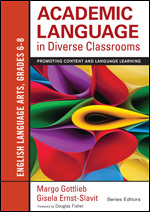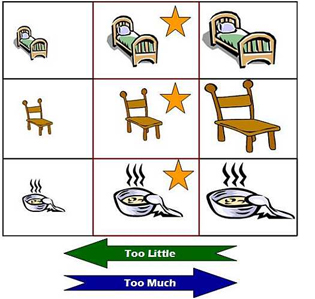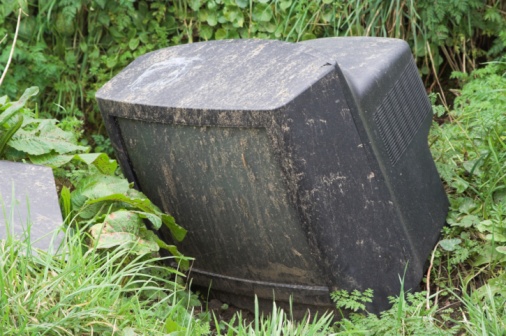Writing "Just Right" Research Questions: Strategies for ELLs
 In my first post in this series about the Common Core and writing, I looked at some general considerations for English language learners (ELLs), including an overview of how the the writing standards are organized in English Language Arts/Literacy. In my second post, I focused on how ELLs' culture might impact their writing and shared some examples from Arabic-speaking students.
In my first post in this series about the Common Core and writing, I looked at some general considerations for English language learners (ELLs), including an overview of how the the writing standards are organized in English Language Arts/Literacy. In my second post, I focused on how ELLs' culture might impact their writing and shared some examples from Arabic-speaking students.
In this final post, I'll now turn to some instructional strategies to support ELLs at the middle school level as they work with an element of one of the CCSS writing anchor standards. I'll conclude with some resources on writing for ELLs.
Writing Anchor 7
Of the ten anchor standards for writing, I chose anchor standard 7 to highlight for this blog post. It reads, "Conduct short as well as more sustained research projects based on focused questions, demonstrating understanding of the subject under investigation." I selected this anchor standard because ELLs may approach research projects from a different perspective than non-ELLs.
One aspect of the anchor standard has to do with creating "focused questions" that generate students' research projects, and in this post I'll focus on supporting ELLs to help them create appropriate research questions. I know from my own dissertation study and subsequent research that crafting the right questions was key to conducting a high quality study, but it takes a lot of practice to be able to formulate solid research questions. In the case of ELLs, teachers will need to pay special attention to supporting their academic language acquisition while helping them write their own questions to guide their written work.
Creating Research Questions at the Middle School Level: Step by Step
 The strategies I will highlight are based on a chapter I co-authored with Darina Walsh, ESOL Coordinator in Fairfax County Public Schools, VA and a former middle school ESOL teacher. This chapter will be included in Margo Gottlieb and Gisela Ernst-Slavit's upcoming Academic Language in Diverse Classroom: English Language Arts, Grades 6-8, to be published in October 2013 by Corwin Press.
The strategies I will highlight are based on a chapter I co-authored with Darina Walsh, ESOL Coordinator in Fairfax County Public Schools, VA and a former middle school ESOL teacher. This chapter will be included in Margo Gottlieb and Gisela Ernst-Slavit's upcoming Academic Language in Diverse Classroom: English Language Arts, Grades 6-8, to be published in October 2013 by Corwin Press.
The research questions are part of a six-week-long unit, titled "Diving into the Depths of Research." The unit is taught by a teacher named Karen in a seventh grade English class of 28 students that contains 14 ELLs at different levels of English language proficiency. In the complete unit, Karen's students use reference materials to produce a research product. For many middle school students (both ELLs and non-ELLs), learning the academic register of research is a new skill. This register of research found in the CCSS is of great value to all students and ELLs in particular.
Step #1: Practice Writing Questions with Literature
To help transition students into generating research questions that will inform their research projects based on their reading informational text, they first create research questions using more familiar topics. Their questions arise from themes found in fiction texts they read in literature circles. (As you may recall, there is still a place for literature in the CCSS – it's not all informational text.) The novels they read inform their crafting of a research question through the connections they make with the text. After they build upon their connection to the themes from their literature circles to generate the research questions, they will then bring in informational texts that support these same themes to conduct their research.
The first part of the unit revolves around teaching students how to formulate research questions that use language forms such as cohesive structures to frame their final research product. The following content and language targets guide this part of the unit:
Content Target: Students will formulate an effective research question that will guide their academic research on a chosen topic.
Language Target: Students will utilize language of cause and effect and problem/solution to create an interrogative research question.
At the students' different levels of English language proficiency, here is what the expectations are for their language use:
| English Language Proficiency Level 1-2 (Beginner) | English Language Proficiency Level 3-4 (Intermediate) | All students, including recently exited ELLs |
| Students reproduce patterned questions. | Students use question frames to produce "just right" questions. Students identify questions as general or specific. | Students pose "just right" research questions using cause/effect, problem/solution and process language. |
Step #2: Defining a "Just Right" Question

http://emusdebuts.files.wordpress.com/2011/06/goldilocks.jpg
The next step is to ensure that students understand what kinds of questions they are trying to write. Karen defines "just right" questions to her class by making the analogy to trials in the story Goldilocks and the Three Bears. To familiarize all the students with the fairy tale and build their background knowledge, she does a quick read aloud to illustrate that Goldilocks always tries three different fits before she finds just the right one. She explains that, much like Goldilocks' "just right" bowl of porridge that is neither too hot nor too cold, "just right" questions are neither too general nor too specific. Also, Karen adds that students may need to pose several questions before finding one that is "just right."
Step #3: Choosing Their Own "Just Right" Question
Since the students have been writing questions all along about the novels they read in their literature circles, jotting the questions down on sticky notes and affixing them to the appropriate pages in their novels, they can use their own questions to practice finding "just right" questions. They self-select their own questions posed throughout their literature circle reading, identifying:
- One question that is too general
- One question that is too specific
- One question that is "just right"
Students then sort the questions into these three categories on their desks. Each student then justifies his or her selections using the vocabulary terms "general" and "specific" in the sentence frames below.
Vocabulary | Sentence Frame | Definition |
| general (adj.) | __________is too general because it ______________________. |
|
| specific (adj.) | ___________________________ is too specific because_____________________. |
|
Then, with a partner, students examine the similarities and differences of the questions they identified in each of the categories in order to build a common understanding together of "just right" questions.
 In order to illustrate this process, let's follow an ELL named Sergio, who has read the first chapter of Andy Mulligan's novel Trash in his literature circle. The questions he generates are:
In order to illustrate this process, let's follow an ELL named Sergio, who has read the first chapter of Andy Mulligan's novel Trash in his literature circle. The questions he generates are:
1. Why do people throw away trash in Behala (the setting of the story?) (too general)
2. Where did the main character (Raphael) get his jeans and T-shirt that he wears? (too specific)
3. How did Raphael become a "trash boy?" (just right)
Step #4: Identifying "Just Right" Research Questions
Karen then explains that the same concepts used with their literature-based questions can be applied to research questions. A "just right" research question should be specific enough to find evidence but general enough to elicit more than a single response. To practice this skill, Karen writes several broad topics on chart paper – one topic per chart. She includes topics and themes that are connected to the students' literature circle novels, such as rights and responsibility, the environment, immigration, and friendship.
Karen then posts the topic charts around the room. As a link to their prior learning, students use a carousel structure to move from chart to chart and write a question about the topic on the chart. They use the research question frames found below to formulate their questions:
- What was the significance of _______________________?
- What is the impact of _____________ on _____________?
- How was _________________________ (problem) solved?
- How did _______________________develop?
Karen purposefully plans opportunities for students to engage in dialogue and question each other about their learning. After students have completed the question carousel, they are given three different color sticky dots to use on the carousel charts to identify if a question is "too general", "too specific," or "just right". In small groups, they then use index cards with sentence frames to discuss and justify why the questions they identified were "just right".
Sergio's group identified a question under the "environment" theme that they deemed "just right." It reads: "What is the impact of poverty on the environment?" This theme connects with the novel Sergio is reading and resonates with him on a personal level.
Step #5: Students Writing Their Own "Just Right" Research Questions
Now students are ready to move on to finesse their research questions and begin conducting their own research projects as well as writing up their findings. They may select one of the "just right" questions generated by the class to frame their projects. They may also choose to create their own research question on a topic of their choice using the research questions they just wrote during the carousel activity.
Karen fin ds that after students begin to research their question, what they find may spark new interests. Students have the opportunity to refine their question or to create a new question based on their early research. Sergio began researching the question "How did recycling develop?" His question then became, "What is the impact of throwing away old televisions?" after he began researching about recycling using informational texts that linked to the theme of the novel Trash.
ds that after students begin to research their question, what they find may spark new interests. Students have the opportunity to refine their question or to create a new question based on their early research. Sergio began researching the question "How did recycling develop?" His question then became, "What is the impact of throwing away old televisions?" after he began researching about recycling using informational texts that linked to the theme of the novel Trash.
Final Thoughts
Although the strategies showcased here for supporting ELLs only address the early stages of this process, the strategies illustrate the kind of extra support needed for teaching ELLs how to tackle complex academic content. In order to create the kinds of research projects called for by the Common Core, teachers will need to help ELLs create the focused questions that will drive their research, while being cognizant of ELLs' need for linguistic support.
Resources on Writing Instruction for ELLs
- Common Core for the Not-So-Common Learner, Grades K-5 by Maria Dove & Andrea Honigsfeld
- The Common Core Writing Book, K-5: Lessons for a Range of Tasks, Purposes, and Audiences by Gretchen Owocki
- The National Writing Project: English Language Learners Network
- Colorin Colorado: Writing Instruction for ELLs
- engageNY: Common Core curriculum modules and units
- Share My Lesson: Free Common Core lesson plans from the American Federation of Teachers
- Teaching Channel: Videos of Common Core lesson plans in the classroom
- LiteracyTA: Writing graphic organizers, activities, and professional development resources (paid subscription)
- Heinemann: Ideas for nonfiction writing in grades K-2
Image credit: http://emusdebuts.files.wordpress.com/2011/06/goldilocks.jpg







Comments
Anne Swigard replied on Permalink
Writing Program for ELLs
This is a wonderful guide to helping ELL students with writing. Really a great resource for any teacher. Thank you so much for sharing. We at Educational Training Specialists, LLC are creating a writing program that trains teachers how to teach ELL students how to write well based on the rich experiences they bring to the classroom. Cannot wait to share it!
Best,
Anne Swigard
Add new comment